The Million Dollar Cowboy Bar
Introduction
Text-to-speech Audio
The Cowboy Bar was began as “Ruby’s Saloon” in the early 1930s before a large renovation and a name change in 1939. Ben Goe Sr. renamed the business to create a more general appeal and draw. His vision was to create a western themed bar where any cowboy or tourist could pull up to the bar and have a drink. The business was successful, and upon Goe’s retirement the mantel was taken up by a succession of owners who added their own flair and character to the building. They all saw it as the keystone business it is today, where locals and tourists alike rub elbows on the dance floor and on the famous saddle barstools.
Images
View of Joe Ruby's Cafe
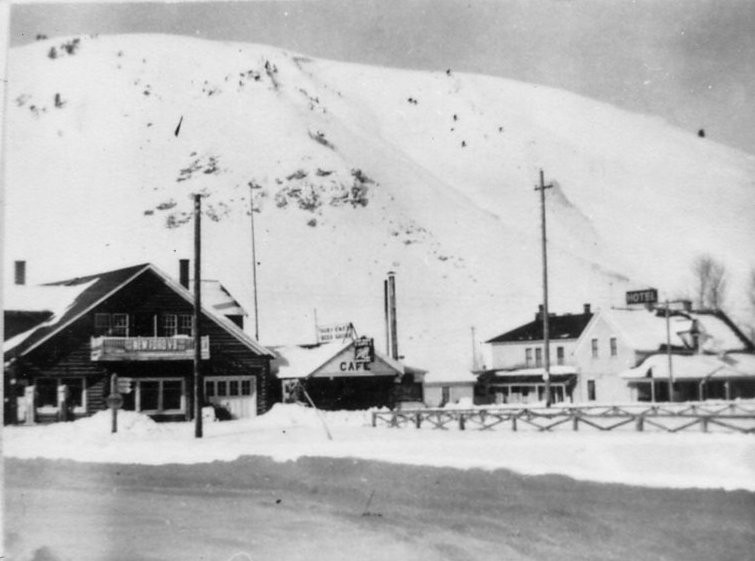
Ben Goe's Cowboy Bar & Moore's Cafe
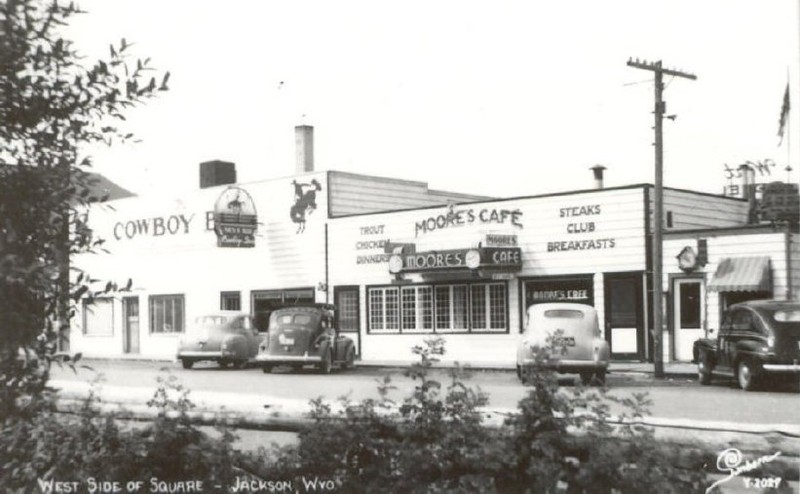
Cowboy Bar Interior Pre-1970s
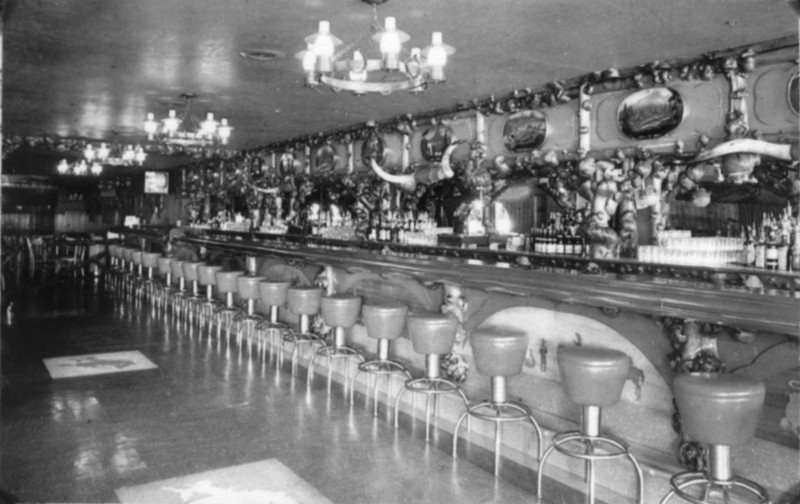
Cowboy Bar Interior
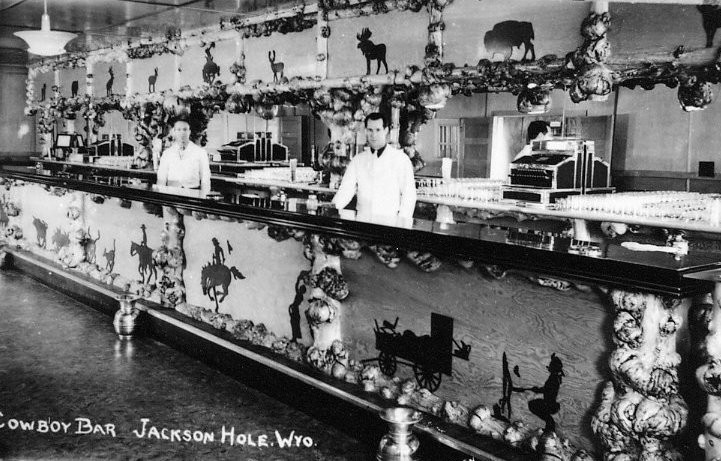
Cowboy Bar Exterior c.1960s
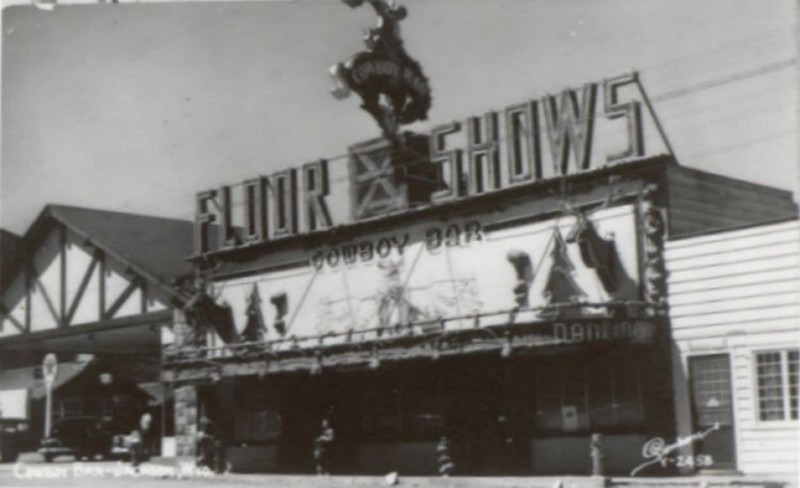
Backstory and Context
Text-to-speech Audio
The Cowboy Bar began its history in 1939 when Ben Goe Sr. purchased Ruby’s Saloon from Joe Ruby, and changed the name. Goe had been the manager of Ruby’s Saloon for about a year when the men decided to make the sale official. Joe Ruby first opened a bar business in the small log building in 1933, though he had previously been fined for possession of alcohol during Prohibition the year prior. This may have happened at his previous business, the Jackson Hole Smoke House, which he owned with Ben Goe Jr. The location and details of the Smoke House are difficult to pinpoint. What is known is that in 1933, he opens Joe Ruby’s Café in the building in 1933. After prohibition, the business became Joe Ruby’s Café and Beer Garden. Joe Ruby’s Bar and Joe Ruby’s Saloon appear to be interchangeable in the newspapers at the time. Ruby was often remodeling and repainting, and adding onto the building several times. In 1936, Ruby refurbished the exterior, adding white clapboards on top of the old logs and installed a big plate glass window.
Ruby also acquired the building next door, which was known as Moore’s Café and eventually joined with the Saloon space in 1938 when Ruby was again doing extensive remodels. Later that year in September, a newly installed stove overheated and caught the chimney on fire, which spread to the ceiling and roof. In classic wild west fashion, the newspaper reported “The evenings activities were soon under way again and little loss in business was experienced by the management.” This wouldn’t be the last time that new equipment would cause damage to the building.
In 1939 after Ben Goe Sr. purchased the property, the first major change occurred to the exterior. The gable peak was removed, and white clapboard siding was added to match the Moore’s Café building next door. The building was enlarged to about double its previous width, with a large square appearance rather than a log cabin with a gable roof. The clapboards uniformly stretched across the main façade, rather than the previous appearance of clapboard and vertical boards. This new cohesive look lent a cohesive appearance to both the Cowboy Bar and Moore’s Café, which were joined on the interior. The interior was enlarged, and a new bar that spanned the entire length of the building was installed. The gnarled trees were carefully selected and hauled out of the nearby canyons and “artistically planned” by “expert workmen.”
Ben Goe’s major upgrades and advertising put the Cowboy Bar on the map for tourists and locals alike as a raucous and lively watering hole. A few years later in 1945, Goe retired and sold the property to Press Parkinson. Parkinson was another visionary in the Cowboy Bar’s history and remodeled the exterior to bring the gnarled pine details onto the street, and added the first neon signs. This new appearance cemented the Cowboy as one of Jackson’s premiere businesses. The neon signs grew as did the reputation for illegal gambling and quality booze.
Gambling had previously been illegal in Wyoming since 1901, but it was rarely enforced. In the 1930s and 40s the state began to crack down on the law. Jackson Hole became a holdout, as the rugged terrain made it difficult for state officials from Cheyenne on the far eastern half of the state to make the journey. Eventually, it became too risky to operate the card tables in plain sight, and they moved into the basement. When state officials were on their way, there was often enough advance warning to hide the evidence. Locals remember having to carry the tables into secret tunnels dug into basements that extend underneath some businesses in town.
In 1953 Press Parkinson was in the basement investigating why a newly installed gas furnace was not working properly. Upon finding the pilot light out, he lit a match to reignite it and disaster struck. The gas had been on, and filling the basement, and the ignition from Parkinson’s match caused an explosion that lifted the building into the air. The old plate glass windows out front blew out, carrying patrons sitting behind them on stools out into the street. The western rear of the building was blown out into the alleyway, and the floor on the first level caved into the basement. Parkinson was injured, but remarkably survived the explosion. His wife in the second floor apartment was rescued from the roof by a ladder. No one was seriously injured, and one woman at the bar lost the heels off her shoes, but was no worse for the wear.
Parkinson was interviewed by the newspaper from his hospital bed, and vowed to rebuild and reopen. Work began almost immediately, and the front third of the building was reopened within a few weeks so business could resume. Much like the earlier chimney fire, the business would go on. Parkinson took out a new million-dollar insurance policy on his new expensive investment, and the name stuck. Now renamed the Million Dollar Cowboy Bar, the building was successfully repaired, and thankfully the oldest portion of the gnarled pine bar was saved.
In 1959, Parkinson sold the Million Dollar Cowboy Bar to a group of local investors who continued to use the same name. They carried out a few extra outstanding projects, and sold the bar to C.A. Poindexter. Like Ben Goe and Preston Parkinson before him, Poindexter had a vision for the building. He installed the now-famous bar stools in 1973, and began a campaign to bring in some of the biggest names in the country western music genre to increase business from across the country. Poindexter was successful, and the live music remains one of the draws to the Cowboy today, along with the saddle barstools.
Consecutive owners continued to refine the business, and kept the old traditions alive through preserving the architecture on the inside and out. The Million Dollar Cowboy Bar marquee is almost as well-known and photographed as the Tetons. Today the Cowboy Bar is one of the longest-running businesses in Jackson.
Sources
Cassity, Michael. "Cowboy Bar." Report prepared for the Teton County Historic Preservation Board, 1999.
"The Cowboy Bar," Jackson Hole News, May 25, 1983.
"Cowboy Bar," If Walls Could Talk Series. Jackson Hole Historical Society & Museum https://youtu.be/XaxeeXnFDbs?si=qbmHxGhujOpEZqhl
"History of the Million Dollar Cowboy Bar," Cowboy Bar Blog. https://www.milliondollarcowboybar.com/blog/history-of-the-million-dollar-cowboy-bar
"The Story of a Gas Explosion That Nearly Destroyed the Iconic Cowboy Bar," By the Cowboy Bar. Buckrail, July 9, 2021. https://buckrail.com/the-story-of-a-1953-gas-explosion-that-nearly-destroyed-the-iconic-cowboy-bar/.
Jackson Hole Historical Society & Museum
Jackson Hole Historical Society & Museum
Jackson Hole Historical Society & Museum
Jackson Hole Historical Society & Museum
Jackson Hole Historical Society & Museum
